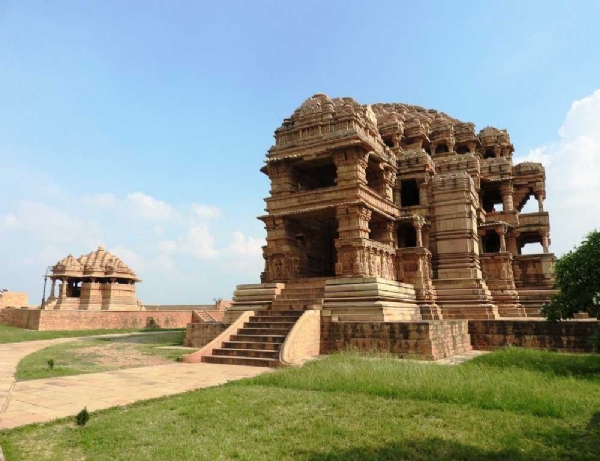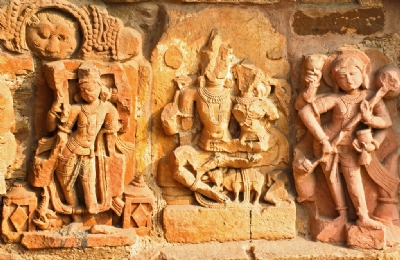Gwalior’s finely carved historical site, the Sahastrabahu temple!
Contrary to popular belief pertaining to the name of the temple being a blend of the Hindi words saas & bahu, it is actually the shortened form of a name of Lord Vishnu - “sahastrabahu” or “he of the thousand arms.”
Total Views |
The 11th century Sasbahu Temple Complex in Gwalior, consists of a pair of temples, one smaller than the other, but both boasting of the most stunning stone carvings. As an inscription at the entrance to the larger of the two indicates, these temples were constructed in 1093 by King Mahipala of the Kachchhapaghāta dynasty. They have stood the test of time as one of the most exquisite examples of temple architecture in India.

The smaller temple, bahu, has the mandapa with a stone seat that runs all around it. The doorway to the now absent sanctum is richly carved, and gives an open view of the city below.

It is best to visit Gwalior during the winter or monsoon, while summers are to be avoided. While the temple will take an hour to look around, the fort will take a whole day to explore, as you will have several monuments to go through.

History | The Kachchhapaghātas came to power in the 10th century and ruled over the northern parts of central India. Gwalior was their main seat of administration. The Kachchhapaghāta kings built many monuments, some of which have survived, like the Sasbahu Temples, displaying a highly ornate style of architecture & impressive attention to detail.
Inside the temple | The temple complex comprises of two temples - one large (saas) and one small (bahu), situated on the eastern end of the fort. The other name for this temple pair is Sahastrabahu - referring to the thousand armed or infinite the Lord Vishnu.
The inscription on the mandapa was deciphered by Alexander Cunningham, and was deducted that construction was started in 1093 CE, during the reign of the Kachchwaha king Mahipala, by Padmapala, the king’s brother. The temples did indeed face large-scale destruction during the Delhi sultanate rule, but have been largely reconstructed and even repaired various times.
You will find every inch of the temples, has been carved. It is a stupendous display of the development of temple architecture under the rule of the Kachchhapaghātas. The temple plan comprises a mandapa, an antarāla and garbhagriha.
While the shikhara of the larger temple isn’t in place, from the remains Cunningham derived that the plan showed a triple storied structure with balconies, and a cross foundation; thus, suggesting that the temple originally followed Bhumija style with a height of more than 100 feet. The larger temple, the saas, has 3 entryways from 3 cardinal directions, and has a mukh mandapa. It has a finely carved entrance way that leads to a pillared main mandapa.
Also Read | Bathu ki Ladi, the submerged beauty of Himachal Pradesh
The entrance way holds a Garuda on the lintel, while Brahma, Vishnu, and Shiva are carved on the panel above it. The carved ceiling of the mukhmandapa is something to look out for. Inside the main mandapa there are four pillars carrying the weight of the upper storey, and are also exquisitely carved. Both the temples boast an impressive range of carvings which depict Hindu divinities such as Brahma, Vishnu, and Saraswati.
The smaller temple, bahu, has the mandapa with a stone seat that runs all around it. The doorway to the now absent sanctum is richly carved, and gives an open view of the city below.

Contrary to popular belief pertaining to the name of the temple being a blend of the Hindi words saas for mother-in-law, and bahu for daughter-in-law, it is actually the shortened form of a name of the Hindu god Vishnu, “sahastrabahu,” or “he of the thousand arms.” The two temples, situated adjacent to each other, were dedicated to Padmanabha - or Vishnu worshipped in his reclining pose.
Also Read | Kopeshwar Temple, the architectural wonder of Khidrapur
Fort | In MP, the Gwalior fort is of special importance, and its history takes it back into 5th century CE, when the Guptas controlled the area. The fort stands on a 300 feet high rocky narrow outcrop that is known as Gopachala which literally translates to the shepherd’s hill.
It is best to visit Gwalior during the winter or monsoon, while summers are to be avoided. While the temple will take an hour to look around, the fort will take a whole day to explore, as you will have several monuments to go through.


